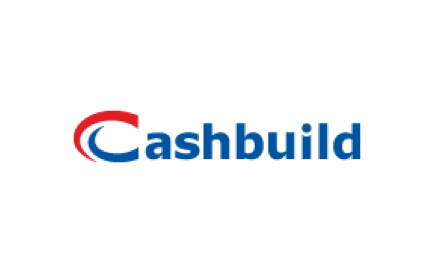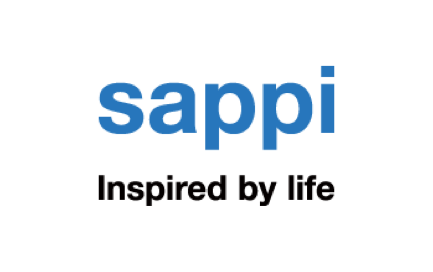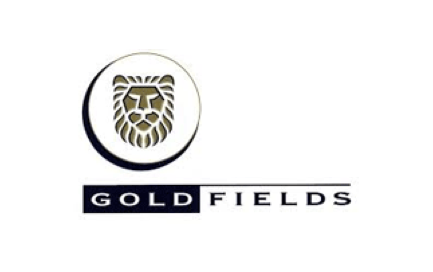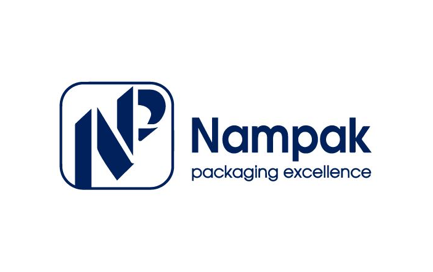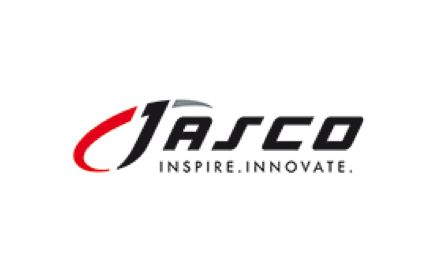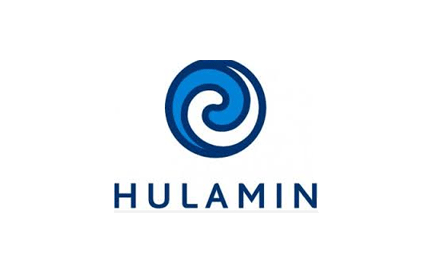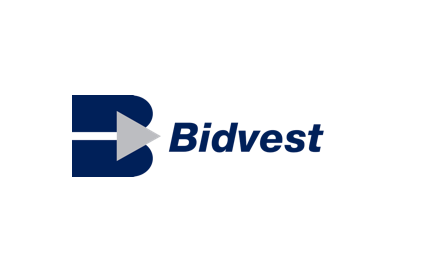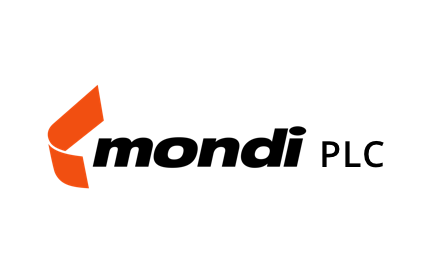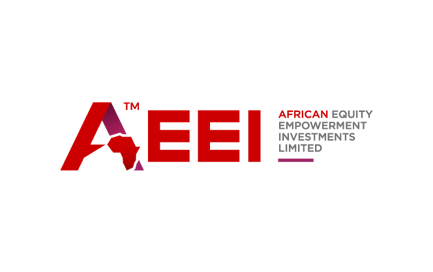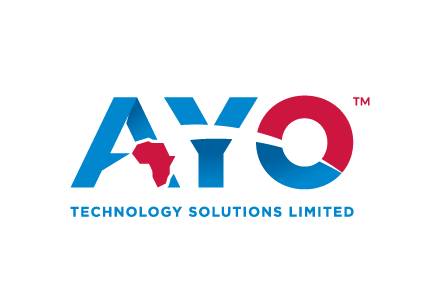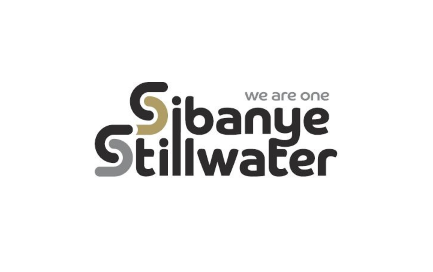Coal and manganese put a shine on African Rainbow Minerals (JSE: ARI)
Headline earnings is up by a juicy 40%
Mining stocks are wild things. African Rainbow Minerals has doubled in price over three years but is down around 6% over the past 12 months. “Buy and hold” generally isn’t the game here.
For the six months ended December, headline earnings increased by 40% to R26.38 per share and the dividend is 16.7% higher at R14 per share.
The net cash position has decreased from R11.2bn at the end of June 2022 to R9.5bn at the end of December, with a R3.5bn payment having been made in September to acquire the Bokoni Platinum Mine. The group is set to invest heavily in that project.
The numbers would’ve been better were it not for logistical challenges, a classic issue in South Africa. Iron ore, manganese ore and thermal coal volumes were negatively impacted. With unit costs under pressure from energy inflation, a practical constraint on volumes really isn’t helpful.
Still, ARM Ferrous grew headline earnings by 4%, including a 54% increase in the manganese division and a 12% decline in iron ore, with lower average prices for iron ore and significant volume decreases both for exports and local consumption. Manganese had the opposite experience in terms of volume and pricing.
ARM Platinum grew headline earnings by 7% and ARM Coal experienced incredible growth that saw headline earnings increase by 4x!
AVI is flat, thanks to pressure in I&J (JSE: AVI)
Margins have taken a knock
Despite an increase in group revenue of 7.2% in the six months to December, AVI could only manage a 0.6% increase in HEPS.
The problem wasn’t at gross margin level, as gross profit grew by 7.8% and hence this margin actually expanded. The group managed to offset many cost pressures through pricing initiatives, which is important. Improved profitability in the footwear and apparel business was also a positive contributor here.
If we exclude I&J, operating profit increased by 8.4%. The fishing business was hit by fuel prices, a reduced quota and an unfavourable abalone sales mix because of Chinese lockdowns. Primary agriculture (or even aquaculture) is no joke, as evidenced by a 54.9% drop in operating profit at I&J.
Although the balance sheet has also come under pressure from increased working capital requirements (a trend we are seeing across the JSE), the interim dividend is still there and has even increased by 1.2%. Keep an eye on that balance sheet though, with cash generated from operations down from R1.71 billion to R1.06 billion. Net debt has increased from R1.54 billion to R2.45 billion over the past 12 months.
As a Strawberry Whirls enthusiast myself, I wasn’t surprised to see strong demand for Bakers Choice Assorted over the festive season.
Bidvest: firing on (almost) all cylinders (JSE: BVT)
Six out of seven divisions delivered profit growth ahead of inflation
With a variety of businesses spanning several sectors, I felt that Bidvest would be a decent pick this year in the industrials sector. I was asked by the Financial Mail to contribute to the Hot Stocks edition in January and Bidvest was my choice in this sector. It seems to be working out thus far!
My bet was that Bidvest would be a beneficiary of this inflationary environment, passing on many of the costs and experiencing the joy of operating leverage (when it works in your favour). The company gave us a strong clue that this would be the case in its last trading update, when they told the market that profit growth was tracking revenue growth.
As proof of why you should read SENS carefully, here’s the excerpt from back in October:
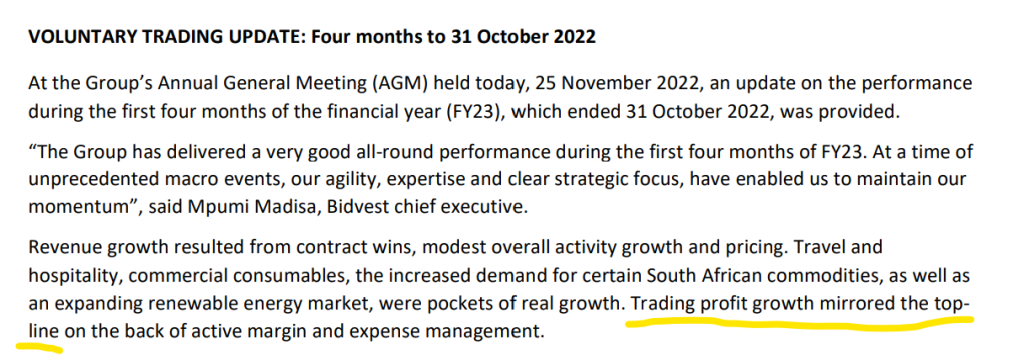
Sure enough, for the six months to December, revenue grew by 14% and trading profit was up 14.5%. Not only did it mirror top-line, but they achieved some margin expansion as well!
HEPS increased by 15.3% and the interim dividend increased by 15%, so cash quality of earnings was high. A steady payout ratio is a great sign that the earnings are being backed up by solid cash flow generation.
As we are seeing in many companies, the balance sheet is also sucking up its fair share of cash. Bidvest generated R7.3 billion in cash from operations and invested R5.5 billion in working capital. In terms of capital expenditure, R1.5 billion was needed for maintenance capex (i.e. keeping the existing business going) and R2.3 billion was used for acquisitions.
Return on funds employed has dropped from 40.4% to 37.6% due to the growth in the balance sheet to support the operations. You can’t win at everything. Interestingly, they also measure return on invested capital, a different way of looking at the relationship between profitability and the balance sheet. On this metric, there was improvement from 15.5% to 16.3%, which is above the weighted average cost of capital. This means that Bidvest is generating economic profits, not just profits, as investors are being more than compensated for the risk involved.
Impressively, six out of seven divisions grew profits in this period at a rate ahead of inflation. Not only is Bidvest proving to be a solid inflation hedge, but the group is achieving real growth as well.
The group sounds upbeat on its prospects, including the opportunity to invest into renewable energy. Given Bidvest’s historical success in investing in entrepreneurial businesses, I wouldn’t bet against them creating a solid renewable energy operation alongside the existing operations, all of which also have opportunity for further growth.
The share price closed 15.3% higher for the day, an exceptional rally for such a large company.
Well hello, Hulamin (JSE: HLM)
A rally of nearly 10% was the reward for solid HEPS growth
In the year ended December, Hulamin reported a number that you won’t see very often: normalised EBITDA rose by 339%! I’m afraid there’s another metric that has “normalised” in front of it, this time normalised HEPS growth of 28%.
With volumes up 7%, the group managed to put pricing up to recoup input cost pressures without breaking demand.
As reported, HEPS actually fell by 46%. The normalisation adjustments refer to “metal price lag” in the business. Based on the market response to this result, it seems that investors are happy with using normalised numbers in assessing performance.
With normalised HEPS of 105 cents per share, the share price of R2.90 is a trailing Price/Earnings multiple of under 2.8x. As a cyclical business, I would encourage you to be very careful of assuming that a low multiple means a cheap share.
There’s a firm offer on the table for Jasco Electronics (JSE: JSC)
Community Investment Holdings is looking to take the company private
Jasco Electronics has been telling us for a while that Community Investment Holdings is looking to make an offer for the company. This is a really small transaction because Jasco is a tiny company, with the offer price set at 16 cents per share and a maximum offer consideration of R24.9 million.
This offer price is only a 4% premium to the 30-day volume weighted average price. A large premium might not be needed here as the stock is so illiquid, so shareholders looking to monetise their holdings may see this as the only way out.
Community Investment Holdings and its associated companies already own 55.34% of the shares in Jasco. The offer will be subject to shareholders approving the delisting of the company.
MAS grows its NAV – but not by much (JSE: MSP)
Retail properties in Central and Eastern Europe are performing well
In the six months to December, MAS achieved a 14.3% increase in adjusted distributable earnings per share. I’m afraid that “adjusted” is the word here, as there are so many once-offs and transactional distortions in these numbers that it is very hard to know where to look.
The key insight I would take from these numbers is that retail properties in the Central and Eastern European region are performing well, with footfall and tenant sales running well ahead of pre-COVID levels.
The tangible net asset value is a useful metric to focus on, increasing by 2.9% to EUR1.44 per share.
Metrofile heads sideways (JSE: MFL)
I suppose that 1% growth is better than a 1% decline!
When revenue is up by 19%, you really hope to see a great result at net profit level. Instead, we find ourselves with a scenario where profits at Metrofile went sideways, indicating significant margin compression in the business in the six months to December 2022.
The revenue growth has been flattered by the acquisition of IronTree Internet Services, which has been included for the full period under review. Without that acquisition, revenue would’ve been up 13% instead. That’s still a solid result in terms of top line growth, but it indicates the level of margin compression that has been suffered here.
The trouble at margin level is due to additional costs and a negative change in margin mix towards lower margin services. If that change in mix worsens or is sustained, that’s bad news for shareholders.
Still, operating profit increased by 5%, so this explains only some of the margin compression. The difference between operating profit and headline earnings is the cost of debt, which has gone firmly in the wrong direction. Net finance costs were 16% higher, driven by higher interest rates and growth in net debt of 10%. The debt increase is primarily because of the acquisition of IronTree, although the debtors balance has also increased.
In summary, Metrofile is clearly facing margin pressure and has executed a risky acquisition at a time when money really isn’t cheap. The company has maintained the interim dividend and even executed a share buyback programme. With an average repurchase price of R3.46 per share and a current price around R3.15, I can’t help but think that the better capital allocation decision would’ve been to reduce debt.
Uncertainty reigns supreme at Nampak (JSE: NPK)
Shareholders have been kept guessing about a possible capital raise
Let’s not beat around the bush here: Nampak is scrambling to save its balance sheet. With an exceptionally complex group structure and an array of African subsidiaries, managing the central treasury of this business is very tough. With too much debt on the balance sheet, it was a recipe for disaster.
After the initial rights offer was proposed to the market, new information emerged about potential capital options that led the company to postpone the general meeting. That adjourned meeting has now been cancelled, which has raised a few eyebrows.
If you read through the noise, the reason for the cancellation of the meeting is that the company is still negotiating with the lenders. Until that negotiation is concluded, Nampak doesn’t know how big the rights offer will need to be.
Shareholders will need to be patient here, as Nampak won’t give further details until the interim results are released in May.
Tick tock. Tick tock.
No dividend and a cautious approach at RCL Foods (JSE: RCL)
All that they can do is focus on what they can control or at least influence
Between load shedding on one hand and volatile input cost pressures on the other, it’s been a tough time for food manufacturers. RCL Foods hasn’t been spared, with the company focusing on “controlling the controllables” as highlighted in this detailed results announcement that the company has placed in Ghost Mail.
Margin pressure is the focus at the moment, with revenue in the six months ended December up by 17.6% and underlying EBITDA down by 9.2%. The net impact on HEPS is severe, taking a knock of 22.4%.
The poultry (Rainbow) and baking business units struggled, which makes for interesting reading alongside recent updates from the likes of Tiger Brands and Premier within Brait. RCL was forced to put pricing increases through in the baking business to offset input cost pressures, with a negative impact on volumes as consumers tightened their belts (perhaps literally, after cutting down on yummy baked goods).
When it comes to the poultry business, recent updates from the likes of Astral Foods and Quantum have laid bare the issues in that industry. Even a terrible pun won’t make any chicken farmers smile at the moment.
With the share price eventually closing flat after a rocky start to the day, it seems that much of this was already priced in at RCL Foods.
STADIO: slow and steady doesn’t win this race (JSE: SDO)
The valuation was pricing in far more growth than this
Growth stocks are wonderful things, provided they keep growing quickly. At some point, if the growth music stops, the share price multiple can unwind and cause pain for investors. This can be the case even if the company is still growing, as the test is whether it is growing quickly enough.
A chart of Curro vs. STADIO is just a fantastic thing over the past year:
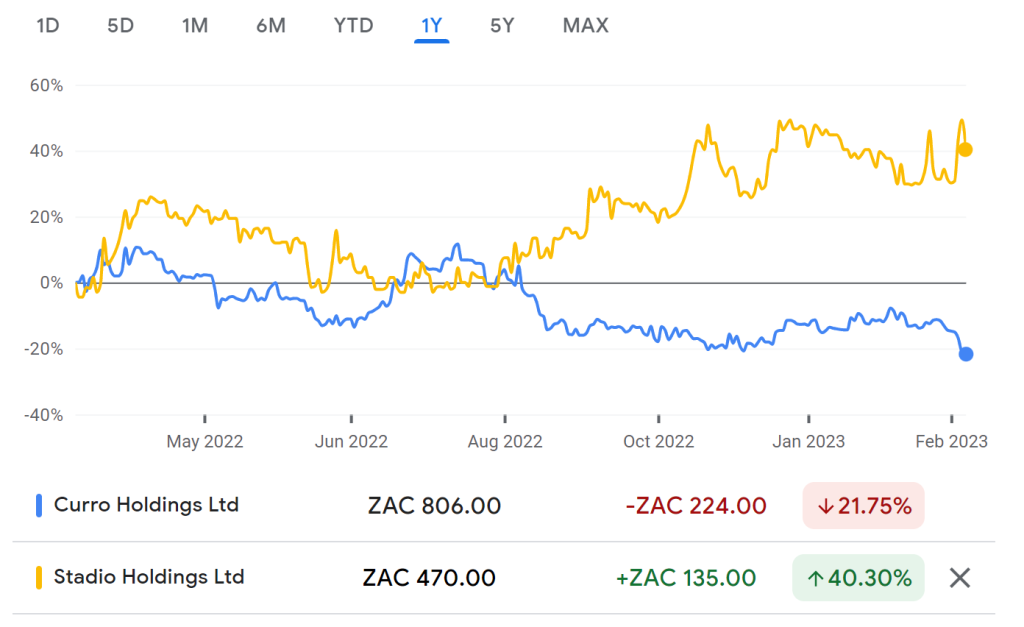
Can that performance gap be sustained? If you enjoy pairs trading, this is one that might warrant some further digging.
Curro is dealing with substantial inflationary cost pressures, particularly in utilities. Running a portfolio of schools is expensive. STADIO is still growing its profits and reaping the rewards of its comparatively asset-light strategy, but growth is slowing. This is a classic value vs. growth debate, playing out right here on the JSE.
Down 6% by close of play, STADIO shareholders were less than thrilled to learn that first semester student growth of 11% slowed to growth of 8% in the second semester. This was still enough to drive growth in core HEPS for the year ended December of between 11% and 23%.
Although it doesn’t affect core HEPS, I also noted the impairment of certain curriculum material (R3.7 million) that the group elected to discontinue. Although I’m sure this is part of business as usual to some extent, it’s not great alongside a slowdown in student numbers. Were some elements of the business just a pandemic fad?
Trading at R4.70 at time of writing, the core HEPS range of 19.6 cents to 21.7 cents suggests a trailing Price/Earnings multiple of around 22.9x at the mid-point. That’s a lofty multiple in South Africa that is only justifiable with substantial growth.
If you want to see the bull case for STADIO, all you need to do is Google the student protests at Wits. University infrastructure is at breaking point in South Africa, leaving space for private institutions to win market share.
Trellidor locks in an 11.5% jump in the share price (JSE: TRL)
HEPS is flat though, so be careful of stocks with low liquidity and high percentage moves
Taking nothing away from Trellidor, one needs to be very careful with getting too excited about large percentage moves in companies that are thinly traded. A rally of 11.5% in Trellidor is nowhere near as important as the 15% rally in Bidvest, for example.
How do you spot this? Well, you just have to look at the daily chart. Here’s Trellidor on Monday vs. Bidvest:

One traded throughout the day, steadily gaining momentum. The other took the slamlock approach, truly on brand. That blue line isn’t something I drew to point to the dot – it’s what happens when the stock only trades during one small part of the day!
With revenue down by 3.6% in the six months ended December and HEPS up by 0.4%, there wasn’t anything to feel excited about in these numbers. The employees that the company was ordered by the Labour Appeal Court to reinstate have been onboarded, with 41 employees presenting themselves for work. 11 decided to take severance packages and 30 are now integrated into the workforce. The company will introduce new products to utilise the additional labour.
Perhaps unsurprisingly, there’s no interim dividend.
Little Bites:
- Director dealings:
- Neal Froneman continues to eat his own cooking, buying a further R9.95 million worth of shares in Sibanye-Stillwater (JSE: SSW).
- A senior executive of Gold Fields (JSE: GFI) has sold shares in the company worth R6.9 million. Again, I can hardly blame him.
- AYO Technology’s (JSE: AYO) battle to hang on to the money that the PIC invested in the company will begin in court on Tuesday. If the court rules that the subscription agreement should be set aside, then this will have a material effect on the AYO share price.
- Sticking with that group, African Equity Empowerment Investments (JSE: AEE) has decided to unbundle its 49.36% shareholding in AYO Technology to shareholders. Assuming this goes ahead, it should simplify the group structure, as investors don’t look kindly on these multi-layered control structures.
- It’s quite rare to see an asset manager with a large stake that could be considered strategic. This hasn’t stopped Allan Gray from increasing its stake in Sappi (JSE: SAP) to over 20% of the company. Allan Gray seems to be hedging its bets in the sector, taking its stake in Mondi (JSE: MNP) to over 6% of the company.
- The merger between Capital & Counties Properties (JSE: CCO) and Shaftesbury has been completed, with the former changing its name soon on the JSE to Shaftesbury Capital with the ticker JSE: SHC. As one would expect, there are also numerous changes to the board of directors.
- Cashbuild (JSE: CSB) shareholders gave overwhelming support to the company’s plan to (1) repurchase a big chunk of shares from the former CEO and (2) execute an odd-lot offer (repurchase shares from shareholders who hold fewer than 100 shares).




